Our quality of life depends, among other things, on a reliable supply of energy at an affordable price. We use energy to heat and cool our homes, to cook and preserve our food, to travel and to build schools, hospitals and roads. We use machines to carry out numerous tasks, contributing to our wealth and wellbeing, and machines need energy. We still burn fossil fuels to obtain most of the energy we use. Moreover, we waste a substantial part of this energy before and during use.
Combustion of fossil fuels affects us all in one way or another. It releases air pollutants into the atmosphere and harms our health. It also releases greenhouse gases and contributes to climate change, causing increasingly severe storms, floods and heatwaves. Our dependence on fossil fuels can alter the pH levels of oceans, deplete the oxygen in lakes and affect crop yields.
It is clear that we need energy but this energy does not necessarily have to be obtained by burning fossil fuels. We are at a critical decision point in time: the negative impacts of our current energy choices on the one hand, and the opportunities that clean energy sources offer on the other. We can choose to prolong our dependence on fossil fuels, increasing the impacts on our health and our planet. Or we can decide to embrace and invest in new and cleaner options while discontinuing some of our current preferences and habits. This might mean that all road vehicles become electric in coming decades, all roofs are covered with solar tiles, all buildings are insulated to prevent heat loss and all products are designed to last longer and be re-used and recycled easily. It might also mean discontinuing subsidies for fossil fuels. Many countries continue subsidizing them, despite repeated commitments and calls on international platforms to phase out such subsidies within a decade.
In the last decade, the political commitment to curb global greenhouse gas emissions has been growing, and it culminated in the Paris Agreement of December 2015. Even in countries where political leaders are sceptical about global efforts, local and regional authorities, businesses, investors and citizens are coming forward and making a commitment to a low-carbon world. Similarly, in this last decade, the research community and businesses have come up with innovations that have led to the growth of solar and wind power generation far beyond any expectations. Thanks to technological developments and effective policy support, including financial incentives, electricity from wind and solar energy has been able to compete in terms of price with electricity from other sources.
As a result, an increasing share of Europe’s energy needs is met by clean renewable energy sources. Renewable energy has been and will be instrumental, not only for achieving Europe’s long-term climate and energy goals, but also for protecting the environment and human health.
Harvest, store, transport, conserve energy
Despite these positive signs, there are still key challenges we must tackle to boost renewable energy production and phase out our dependence on fossil fuels. The sun provides our planet with ample amounts of clean energy. However, we are still not able to harvest, store and transport this energy at a scale sufficient to allow us to use it when and where we need it.
This is much more than a technological challenge. It entails a different way of generating and using energy, moving from a very limited number of large producers favouring certain fuels to more decentralised power generation by many producers, tapping into local renewable energy potential. A decentralised and widespread power generation capacity can also contribute to Europe’s energy security and allow the surplus to be transported from energy-rich regions to those facing shortages. At the local level, this new approach might mean that households become producers of energy, selling their excess production to their neighbours through smart grids. At regional, national and European levels, it would entail connecting energy networks and stakeholders.
Energy efficiency — and resource efficiency in general — is an equally vital component of Europe’s long-term sustainability goals. In general, only a part of the initial energy is actually used in providing goods and services and contributing to our quality of life. Technological improvements, better insulated buildings, smart grids, energy efficiency standards and labels, and, most of all, smart behaviour by energy users — all of us — can help minimise energy loss.
Some sectors, transport for example, might have a harder time than others in switching to cleaner energy alternatives. In road transport, electricity generated from renewable sources can become a viable alternative to fossil fuels but the infrastructure, such as a network of charging stations, needs to be developed accordingly. Biofuels can also contribute to reducing fossil fuel use in transport but their overall benefit needs to be measured against a number of factors, including their potential pressures on land and water use during production.
Clean energy in the making
Despite such challenges, the transition to clean energy is already happening across Europe. Homeowners, cities, companies, regional authorities, national governments and the European Union (EU) are taking action by building smart grids, installing solar and wind power, investing in innovation and adopting standards and labels. Frontrunner towns once known for their coalmines are embracing innovation and renewable energy sources, attempting to tackle their decades-long history of unemployment in the process. The renewable energy sector in Europe continued to grow despite the economic downturn of 2008 and is now providing jobs to more than 1 million people. Researchers are exploring how to harvest more of solar or tidal energy. However, such small-scale efforts and initiatives need to be taken up much more widely across the continent and economic sectors.
Some difficult questions will need to be answered along the way, including how to support the communities that will be affected by the economic restructuring resulting from the discontinuation of unsustainable technologies and activities. Or, whether or not all of the renewable energy sources can be considered clean in the long run and if we will need to rely on some bridging technologies in the short and medium term.
As for any fundamental change, this transition needs time and resources, supported by long-term policy goals and support measures. Making the entire infrastructure and power generation capacity smart and clean will take decades. The European workforce will also need to acquire new professional skills, especially in communities that are highly dependent on fossil fuels, such as coal. And the choices and investment decisions we make today will lock us into a path for the decades to come.
In a world where the global demand for energy and natural resources is expected to multiply, and climate change impacts to intensify, there is only one viable option. That is what the EU has been working towards: a low-carbon circular economy, an Energy Union focusing on renewable sources, energy efficiency, security and affordability, all supported by funds investing in infrastructure, new skills and innovation.





